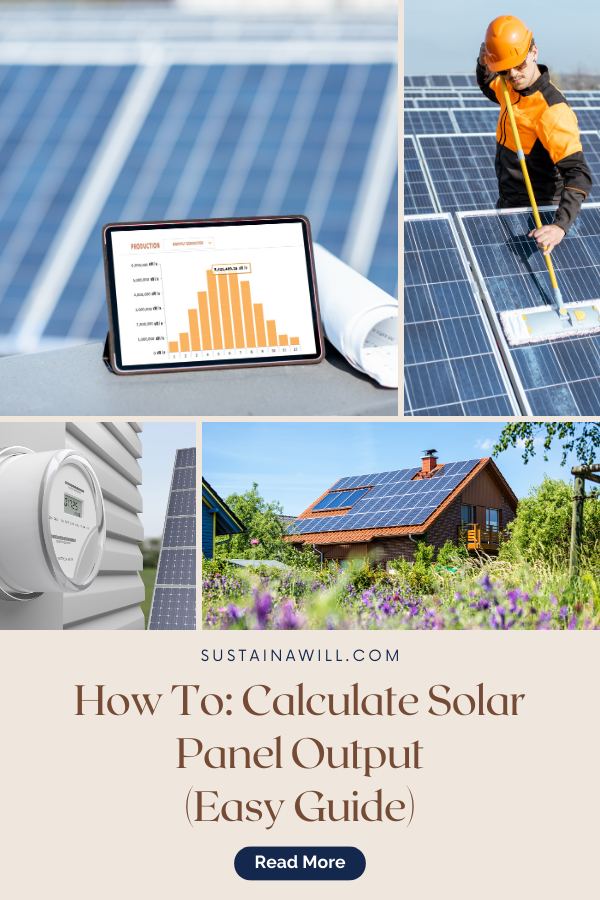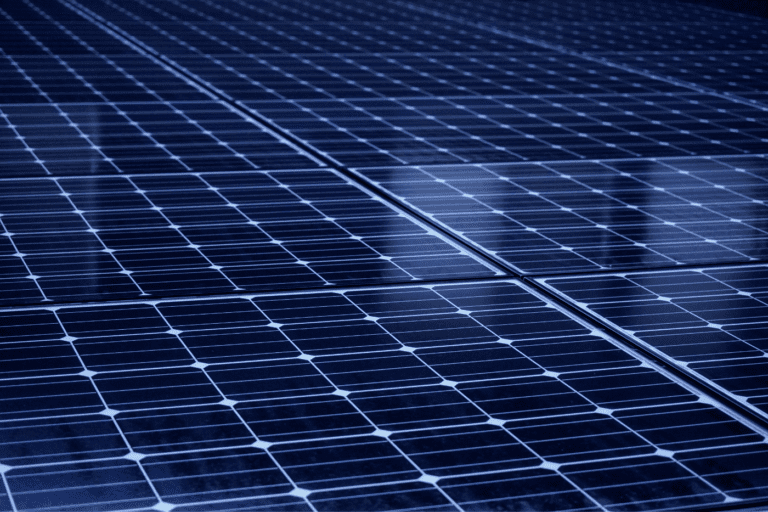Are you curious about solar panel output but don’t know exactly how it’s properly calculated? This guide will solve your problem!
Even if math was never your strong suit, reading on will transform you into a solar output calculating pro.
In the next paragraphs, we’ll demystify the complexities, give you a helpful table with estimated outputs for popular wattages, and empower you to calculate the output of any available solar panel out there.
Why Solar Panel Output Is Important
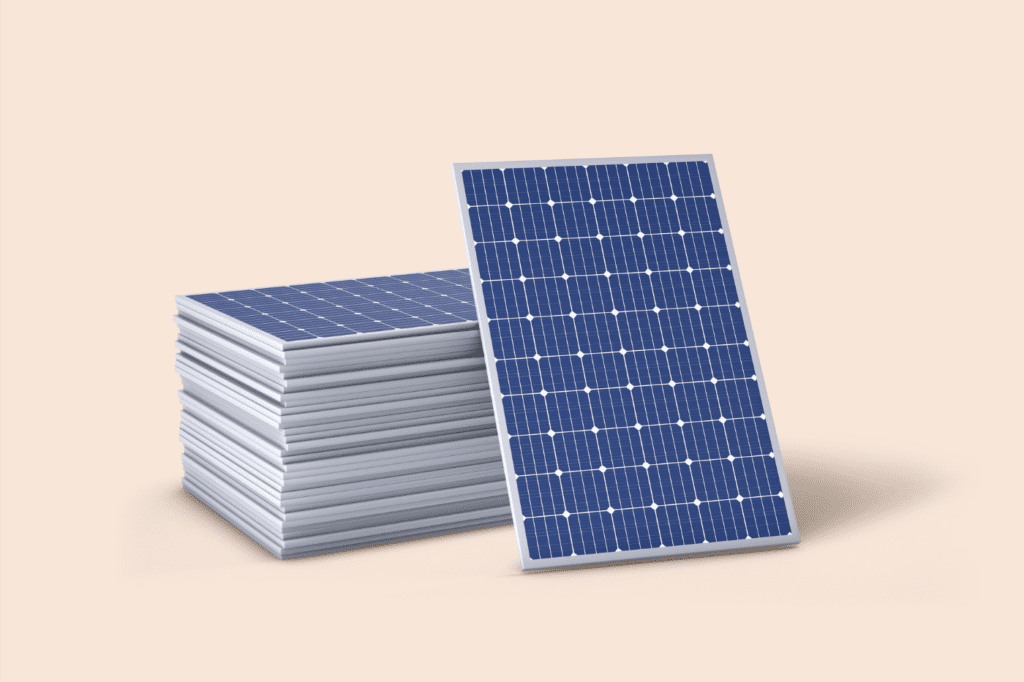
Solar panel output is a key factor in understanding the efficiency and effectiveness of your solar energy system. Here’s why it matters:
- Energy Independence: Higher output means more electricity generated, reducing reliance on the grid and fostering energy independence.
- Cost Savings: Efficient panels generate more power, maximizing your investment and leading to potential savings on electricity bills.
- Environmental Impact: Increased output means a greater contribution to clean energy production, reducing carbon footprint and environmental impact.
- System Sizing: Knowing the output helps determine the right number of panels, optimizing your solar system for your specific energy needs.
- Performance Monitoring: Regularly monitoring output ensures your system is functioning optimally, identifying issues early for prompt resolution.
Key Considerations for Solar Panel Output
- Efficiency Rating: Higher efficiency panels convert more sunlight into electricity.
- Daily Sunlight Hours: The number of peak sunlight hours affects daily output.
- System Losses: Accounting for losses due to shading, temperature, and other factors provides a realistic output estimate.
Understanding solar panel output helps you to make informed decisions, ensuring your solar investment aligns with your energy goals.
How Do I Calculate Solar Panel Output?
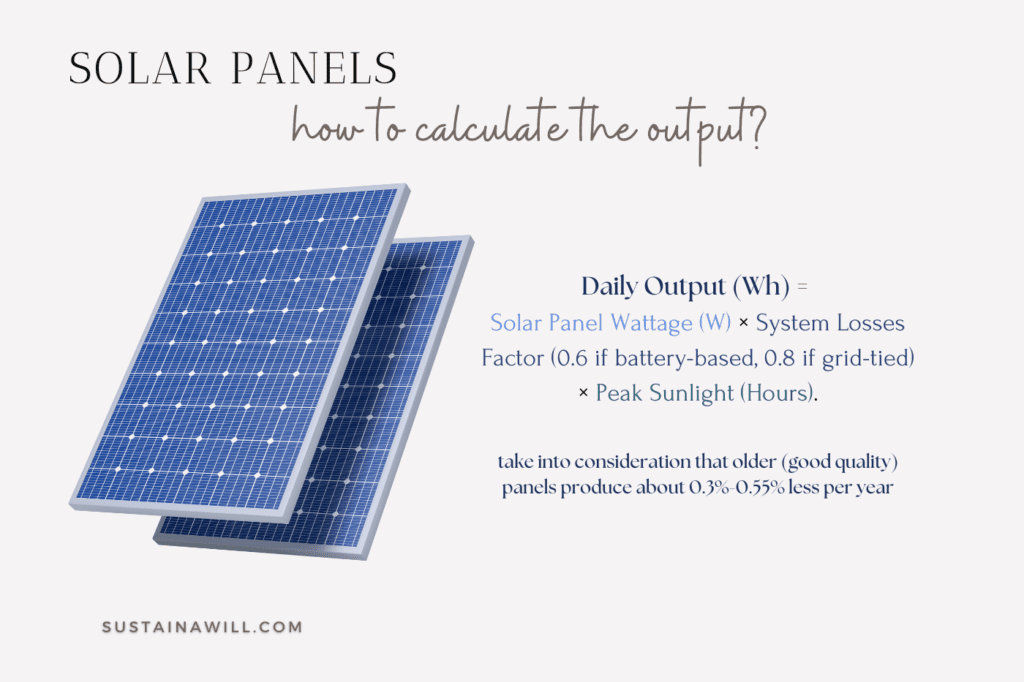
Calculating the potential output of solar panels involves a few key steps to help you gauge their efficiency and estimate energy production. Here’s a step-by-step guide:
Step 1: Determine Your Daily Energy Consumption:
Begin by understanding your daily energy needs. Check your electricity bill to find out how many kilowatt-hours (kWh) you consume on average each day.
This will ensure that you understand what the calculated wattages mean for you as a potential solar panel investor.
Step 2: Assess Sunlight Hours
Research the average peak sunlight hours in your location. The National Renewable Energy Laboratory (NREL) provides online resources to help you determine the sunlight hours specific to your region.
But, to simplify the estimation process, consider a solid 5 hours of peak sunlight each day as a baseline. If you’re uncertain about the specific peak hours in your area, this approximation provides a good starting point for calculating solar panel output.
Step 3: Factor in System Losses
Consider system losses, including shading, temperature, and inverter inefficiencies. For grid-tied systems, losses are typically around 15-20%, while battery-based systems may have higher losses.
Step 4: Use the Formula
Daily Output (Wh) = Solar Panel Wattage (W) × System Losses Factor (0.6 if battery-based, 0.8 if grid-tied) × Peak Sunlight (Hours).
to convert that into kWh, divide the result by 1000, because 1kWh = 1000W.
EXAMPLE
1) Let’s say that your state has 5 hours of peak sunlight hours, your system is grid-tied and you have 1x 500W panel:
500W × 0.8 × 5h = 2000Wh
2000Wh /1000 = 2kWh
This means that the estimated output of a good quality 500W solar panel tied to the grid system are approx. 2kWh.
2) Let’s say you have 2x 400W panels:
2×400W × 0.8 × 5h = 3200Wh
3200Wh/1000 = 3.2kWh
This means that the estimated output of 2 good quality 400W solar panels tied to the grid system are approx. 3.2kWh.
Note
These are simplified calculation, and real-world conditions may vary.
Professional assessments and online solar calculators can provide more accurate estimates tailored to your situation (like considering the state you live in + the quality of the solar panels).
Additionally, ongoing monitoring helps fine-tune your expectations based on actual performance. ☀️🔢
Step 4: Calculate Monthly and Yearly Output
Extend the calculation to estimate monthly and yearly output if needed. Multiply the daily output by the number of days in a month and then by 12 for an annual estimate.
Step 5: Consult with Professionals
For precise calculations and personalized insights, we advise you to consult with solar professionals. They can account for specific variables like panel tilt, orientation, and local climate conditions.
Step 6: Understand that Panel Efficiency Will Drop
Solar panels will experience a decline in energy output over time, and the extent of this decline depends on the quality of the product.
For instance, First Solar, a reputable industry player, ensures an impressive output efficiency of 96.8% after 5 years of use.
Furthermore, looking ahead, First Solar commits to maintaining an output efficiency of around 95% after 10 years.
So, for a satisfying and long-lived solar output, we advice you to stick with a brand that offers robust warranties.
Solar Panel Output Guide
| Panel Power Rating | Average Daily Output | Average Monthly Output | Average Yearly Output |
| 200 watts | 0.8 Wh | 24 kWh | 292 kWh |
| 300 watts | 1.2 kWh | 36 kWh | 438 kWh |
| 325 watts | 1.3 kWh | 39 kWh | 474 kWh |
| 350 watts | 1.4 kWh | 42 kWh | 511 kWh |
| 375 watts | 1.5 kWh | 45 kWh | 547 kWh |
| 400 watts | 1.6 kWh | 48 kWh | 584 kWh |
| 450 watts | 1.8 kWh | 54 kWh | 657 kWh |
| 500 watts | 2 kWh | 60 kWh | 730 kWh |
With help of these solid estimates you can determine how many solar panels you need to power your home sustainably!
How many solar panels do I need?
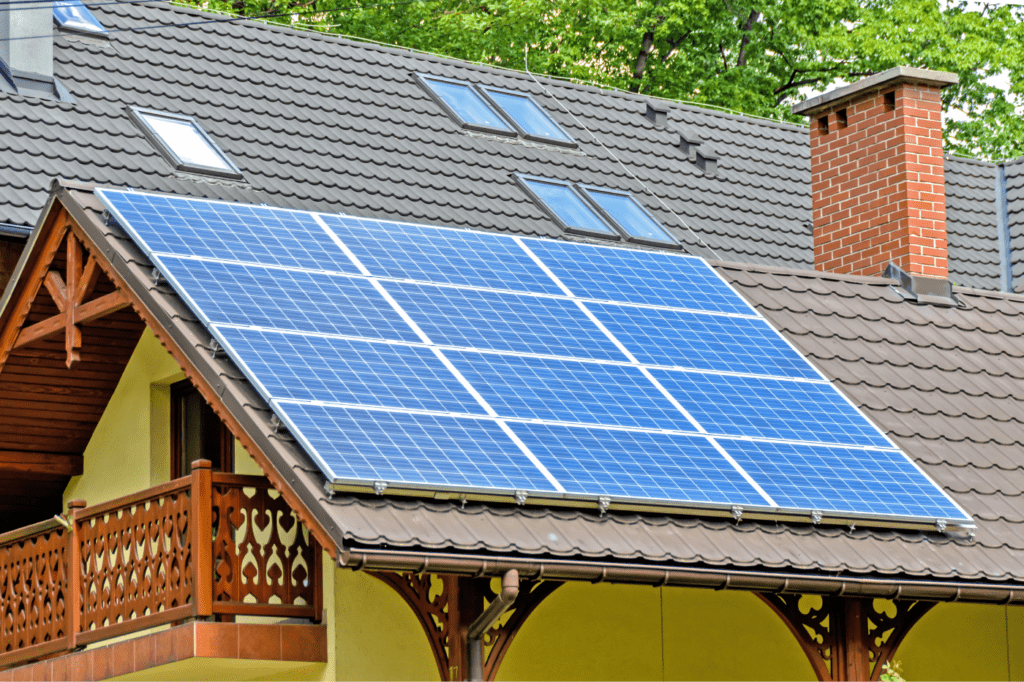
Determining the number of solar panels needed depends on factors like energy consumption, location, and panel wattage. A general estimate for an average U.S. home might be 20 to 30 panels.
Discover the detailed considerations in our full guide on calculating how many solar panels are required to power a house here.
What Affects Solar Panel Output?
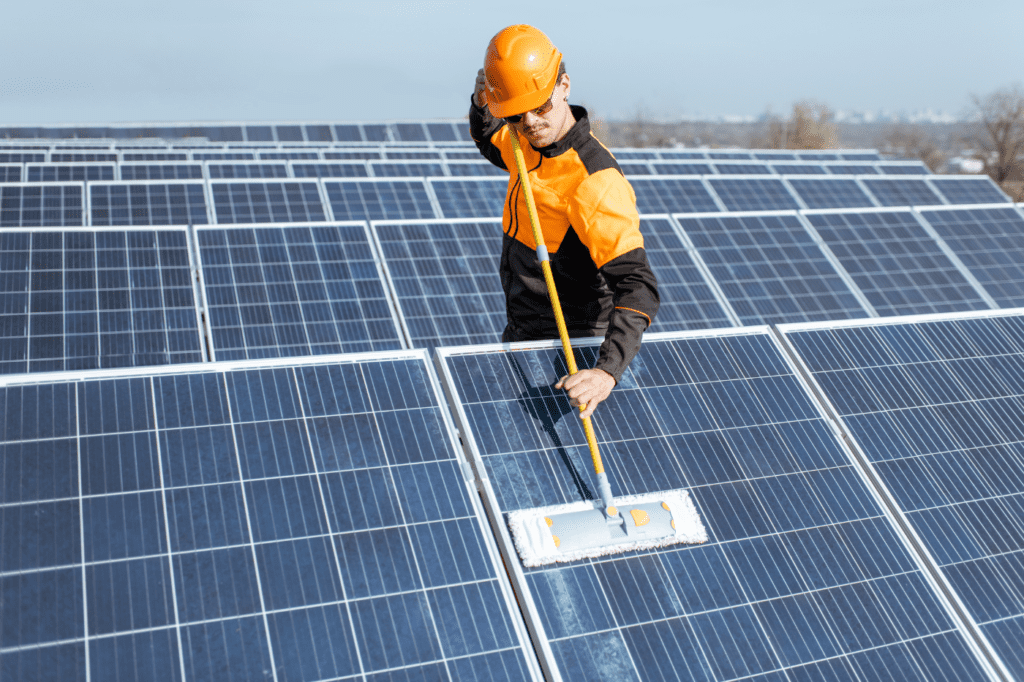
Solar panel production can be influenced by various factors, impacting the efficiency and output of your solar energy system.
Here’s a breakdown of key considerations:
- Sunlight Intensity: The power output of solar panels is directly linked to the intensity of sunlight. Overcast days or shading from trees and buildings can reduce intensity and, consequently, production.
- Solution: Trim or remove shading obstacles, ensuring panels receive maximum sunlight exposure.
- Solution: Trim or remove shading obstacles, ensuring panels receive maximum sunlight exposure.
- Sunlight Duration: The number of hours of sunlight a panel receives directly affects its total energy production. Longer exposure to peak sun hours enhances overall output.
- Panel Orientation and Tilt: The angle at which panels are installed and their orientation toward the sun impact efficiency. Proper alignment ensures optimal sunlight exposure.
- Solution: Consult with professionals to ensure panels are installed at the optimal angle and orientation for your location.
- Solution: Consult with professionals to ensure panels are installed at the optimal angle and orientation for your location.
- Temperature: Solar panels are generally less efficient at higher temperatures. Extreme heat can lead to a slight reduction in power output.
- Panel Efficiency: The inherent efficiency of the solar panel itself plays a vital role. Higher-efficiency panels can convert a larger proportion of sunlight into electricity.
- Dirt and Debris: Accumulated dirt, dust, or debris on the surface of panels can hinder sunlight absorption, reducing efficiency.
- Solution: Establish a routine cleaning schedule to keep panels free from dirt and debris.
- Solution: Establish a routine cleaning schedule to keep panels free from dirt and debris.
- Inverter Efficiency: Inverters convert the DC electricity generated by solar panels into usable AC electricity. Inverter efficiency is crucial for overall system performance.
- Solution: Regularly monitor and maintain inverters, ensuring they operate at peak efficiency.
- Solution: Regularly monitor and maintain inverters, ensuring they operate at peak efficiency.
- System Losses: Factors like wiring, inverter losses, and other technical components contribute to overall system losses, affecting the final output.
- Solution: Work with professionals to optimize the overall system design, minimizing losses.
Understanding these factors will help you optimize for maximum efficiency and make your solar panels last longer!
What Happens If My Panels Produce More Electricity Than I Need?
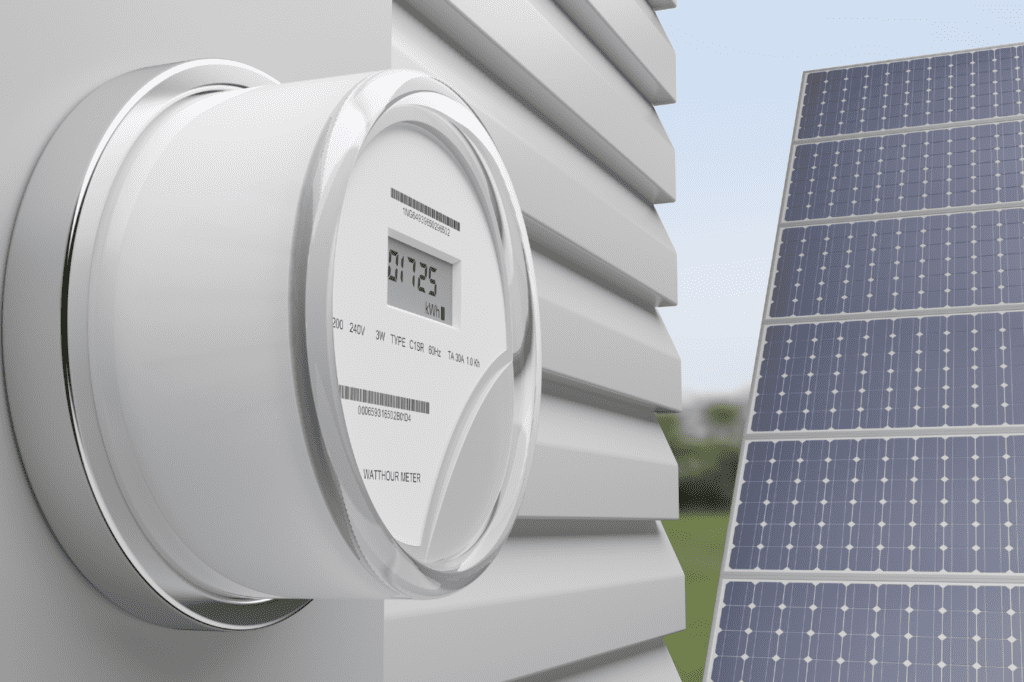
If your home solar system generates more electricity than you consume, it’s a positive scenario known as “excess energy production.”
Here’s what typically happens and how you can make the most of it:
- Net Metering:
- Excess electricity is fed back into the grid.
- Many regions offer net metering, allowing you to receive credits for the surplus energy.
- These credits can be used when your panels produce less than needed, such as during nighttime or winter.
- Feed-In Tariffs:
- Some areas offer feed-in tariffs, where excess energy is sold back to the utility company.
- You get compensated for the surplus energy, providing an additional income stream.
- Battery Storage:
- Store excess energy in batteries for later use.
- use it during periods of low solar production or power outages.
- Community Solar Programs:
- Contribute excess energy to community solar programs.
- Tip: In some cases, you can share your surplus with neighbors or participate in community programs, promoting local renewable energy.
- Contribute excess energy to community solar programs.
System Sizing Considerations
You may have unintentionally overestimated your energy needs.
Tip
Carefully calculate your energy needs to avoid oversizing the system. An appropriately sized system ensures efficient energy use without excessive surplus.
Monitoring your energy production and consumption allows you to optimize your solar investment effectively, ensuring you benefit from excess electricity without wastage.
Are My Solar Panels Working Efficiently? (+Helpful Tips)
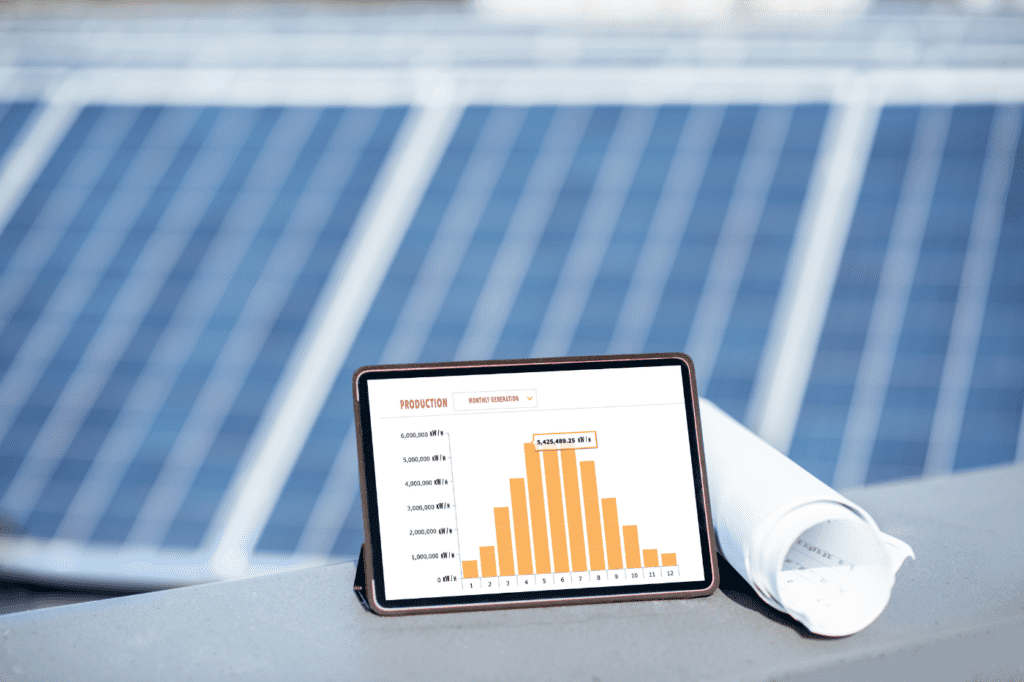
Ensuring your solar panels operate at peak efficiency is crucial for maximizing your investment and sustainable energy production.
Here’s how to gauge the efficiency of your solar panels and some helpful tips:
- Monitor Energy Output:
- How to: Regularly check your energy production metrics provided by your solar monitoring system or inverters.
- Tip: A noticeable drop in energy production could indicate issues with individual panels or the entire system.
- How to: Regularly check your energy production metrics provided by your solar monitoring system or inverters.
- Inspect for Physical Damage:
- How to: Conduct visual inspections for physical damage or wear on the panels, including cracks, water damage, or debris.
- Tip: Address any visible issues promptly to prevent further damage.
- How to: Conduct visual inspections for physical damage or wear on the panels, including cracks, water damage, or debris.
- Check Inverter Performance:
- How to: Monitor your inverter’s performance, as it plays a crucial role in converting DC electricity to AC.
- Tip: Inverter issues can impact overall system efficiency, so prompt attention to malfunctions is essential.
- How to: Monitor your inverter’s performance, as it plays a crucial role in converting DC electricity to AC.
- Assess for Shading Issues:
- How to: Examine for shading issues caused by new structures or growing vegetation.
- Review Historical Data:
- How to: Analyze historical energy production data to identify patterns or deviations.
- Understanding seasonal variations and long-term trends helps in optimizing system performance.
- Professional Inspection:
- How to: Schedule periodic professional inspections by certified solar technicians.
- Professionals can identify potential issues and conduct in-depth assessments for optimal performance.
- Clean Panels Regularly:
- How to: Implement a routine cleaning schedule to remove dirt, dust, or bird droppings from the panels.
- Stay Informed on Technology Updates:
- How to: Keep abreast of advancements in solar technology that could enhance the efficiency of your system.
- Upgrading certain components or adopting new technologies may improve overall performance.
By following these tips, you can maximize the lifespan and performance of your solar energy system.
Conclusion: Empower Your Home with Solar Brilliance
Now you know the nitty gritty about calculating solar panel output, a key step towards a sustainable energy future.
Now, envision a home liberated from energy bills and contributing to a cleaner planet.
Here’s your call: seize the solar opportunity. Calculate your potential, embrace energy independence, and step into a greener tomorrow.
Reach out to professionals, explore innovations, and let the sun power your journey. The future is bright – make it solar!
